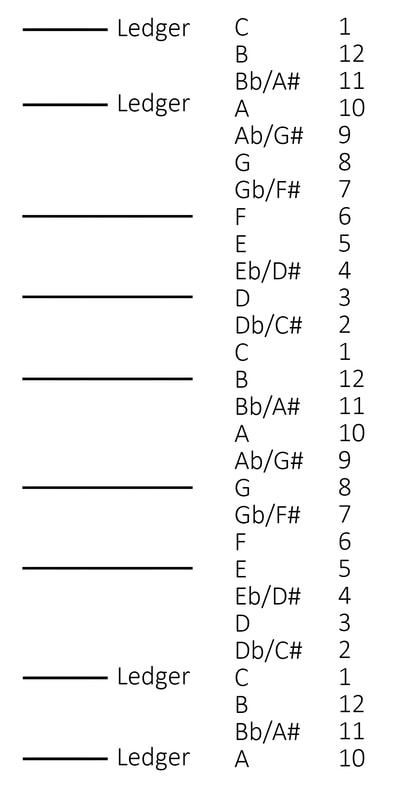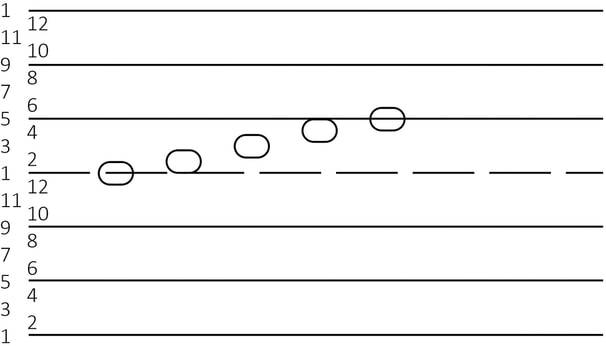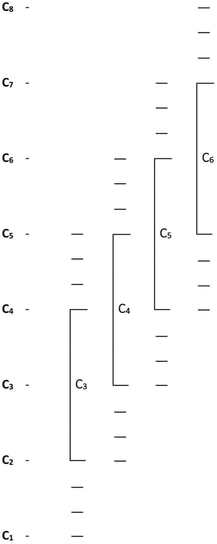By Steven Heath
Dodici Alternative Music Notation can make music easier to play for beginners and experts. Learn about a significant improvement over standard music notation.
The traditional or standard music notation system with all its fascinating history does work but it makes playing music difficult for beginners to learn and makes music more complicated than it could be. Musicians who have spent years learning standard notation would not want to change but beginners could be given a choice.
I have designed a system that I call Dodici (pronounced doe-dee-chee) Alternative Music Notation. Dodici is the Italian word for “twelve” which is the number of “semitones” (also called half tones) in an octave and is in the language of Guido of Arezzo, an Italian monk who, around the year 1025, made significant advancements in music including staff notation and the “do,re,mi,fa,so,la,ti,do” concept.
There are Three Elements of Dodici which will be discussed after the “problems” section below.
Let’s begin with some of the problems with standard music notation:
- Often many ledger lines are used above or below the clefs.
- The relationship between notes, how far one note is above or below another, is not very intuitive when using letters with sharps or flats for notes.
- The treble clef is different from the bass clef. For example, the top line of the treble clef is F while the top line of the bass clef is A.
- A given note is sometimes centered on a line and sometimes between lines.
- Each sharp and flat has two names for it (Bb=A#).
- Some notes do not have a sharp or flat between them.
- Music is written in different keys which can have many sharps or flats. This is shown only at the beginning of a line of music. Musicians must remember which notes to play sharp or flat throughout the entire line. The key sometimes changes in the middle of a song.
- “Accidental” symbols must be used to modify the pitch of notes.
- All music for the many instruments not considered in the key of C must be transposed.
- Often the player of one instrument cannot play another instrument’s music in key (can’t look over the shoulder of the piano player and join in).
Start Learning Immediately
The First Element of Dodici Alternative Music Notation is that players, especially beginners, of any instrument can start using the system immediately to make learning songs easier. The white keys on a keyboard in Figure 1 are numbered with small stickers. Number 1 is on the C keys. The black keys (sharps and flats) are not numbered in Figure 1 but they are always numbers 2, 4, 7, 9, and 11. Keys 1 through 12 make up an octave (standard C through B). There is no black key between 5 and 6 or between 12 and 1 because there is actually only one-half tone between those.

The way to use the Dodici system right away for a keyboard or piano is to use stickers to number keys as in Figure 1 and then make a card showing standard letter notes and flats/sharps on one side and the Dodici numbers on the other (Figure 2).

Then get some sheet music and write the correct number close to every note in the song. I use an extra fine point red ink ball point pen for marking numbers. This takes some time at first but becomes much faster as you memorize which number goes with each semitone.
From then on, anyone including children can play the song by the numbers easily rather than with difficulty. As you can see, the method lends itself best to keyboard instruments but players of other instruments can memorize which fingering corresponds to each of the note numbers.
Improved Notation System
The Second Element of Dodici is its improved music notation system. We now have 12 semitones in an octave to represent on a staff. We could use many more lines or we could have more notes contained between lines. Some alternative music notations use a method where one note is centered on a line, another sits on a line, another floats between lines, and the last hangs from a line. I call them liners, sitters, floaters, and hangers. Figure 3 displays this method on a Dodici staff explained below.

Dodici notes are zeros which vary from skinny zeros to very elongated zeros called “stadiums”. The notes each get a bit longer as they increase in duration but not proportionally longer. This allows ease and speed of handwriting notes while providing the intuitiveness of longer notes for longer duration. Breaks at the quarter note point are shown with vertical lines within the stadiums in Dodici and are very important. Figure 4 illustrates note duration as a fraction, standard notes, Dodici notes, and Dodici rests.

Dodici uses a seven line per staff system with the center line being dashed to aid with orientation. This has several advantages including reducing the number of ledger lines needed. Figure 5 shows one staff with Dodici number 1 (standard C) as the top, center, and bottom lines. The locations and numbers of all notes are shown along with a chromatic scale. Odd numbers are liners or floaters. Even numbers are sitters or hangers. All lines and ledger lines are numbered 1, 5, or 9. Each staff contains two octaves but if it is extended three ledger lines above and three below, it can handle four octaves plus five semitones. This more than covers the full range of almost every instrument.
A staff with numbers as in Figures 3 and 5 could be used by beginners. Music could be transferred or composed onto Dodici staves and could easily be converted from standard notation to Dodici using software yet to be developed.

Figure 6 displays the first two lines of “Frosty the Snowman” in standard notation, how it looks in Dodici notation, and how it looks if someone wrote it by hand very quickly in Dodici. Frosty is a very simple song but Dodici works equally as well with complex music. Notice that the Dodici notes are easily distinguishable from each other. Anything that resembles a zero is an eighth note. Anything that is somewhat longer than a zero with no vertical lines in it is a quarter note. Anything that is an elongated zero (stadium) with a vertical line near the right side represents a quarter note plus an eighth note, and so forth. When handwriting rapidly it is easy to indicate whether a note is centered on a line, sitting on a line, floating between lines, or hanging from a line.

Dodici also allows for microtonality which means tones that are between the Dodici semitones. Figure 7 depicts some Dodici 3 notes, 4 notes, and 5 notes. One way to illustrate microtones is mathematically. Starting with note 3 we move to note 3 with an upward arrow. I call that note 3.25. The next note has two upward arrowheads which means it is halfway between 3 and 4 or 3.5. The next note is a number 4 with a downward arrow. That signifies 3.75. If we were to put two downward arrowheads on number 4 it would be 3.5 but I would not use that because 3.5 already has a symbol which is note 3 with two upward arrowheads.

Standard (or any other) notation symbols can be used for optional and supplementary information not covered in this paper. I would eliminate the large bold C which is sometimes used to indicate 4/4 time because the Dodici clefs will be designated with a bold C.
Use of Clefs
The Third Element of Dodici concerns the use of clefs. Dodici is based on the full range of an 88-key piano. All the C notes are the anchors and are named 1. The lowest sounding C on a piano is called C1 and the highest C8. Figure 8 illustrates the locations of the standard treble and bass clefs and what I call the Dodici C3 and C5 clefs.

The Dodici system uses four overlapping clefs called C3 through C6 (Figure 9). The C2 or C7 clefs could also be used if needed but are not shown. All the clefs are identical except that they are spaced at one octave intervals. The Cs (1s) are always the center of a clef and the top and bottom lines of a clef.
The reason for the overlapping clefs is that if Dodici was in use, a beginner playing any instrument would use the Dodici clef that most closely matches the concert range of that instrument and non-transposed sheet music would be available for that. For example, an alto saxophone has a range of concert Db3 up to A5. In Dodici that is 2-3 up to 10-5. The C4 clef would be best for that and the sax player would use a maximum of two ledger lines above the staff and none below. A tenor sax player would use C4 with one ledger line above and one below.
Some instruments would require three ledger lines either above or below the clef and only a few instruments would need four. The piano would use C3 and C6 to cover its full range.

Notes and Conclusion
A new Dodici based design for keys on keyboard instruments could be introduced.
I realize that the entire range of an instrument would take up a lot of vertical space on a page. After making the staff as small as feasible, perhaps only the two thirds of the range that is currently in use in a song would need to be depicted. This two thirds section would shift up or down occasionally as the song progressed but the dashed note number 1 line would always be there for reference.
Those musicians who play more than one instrument in the same family but in different keys could acquire transposed music for the additional instrument(s) in order to maintain the same fingerings and written range.
With the Dodici system, all music, except some of that used by musicians who play more than one similar instrument, would be written in concert pitch. I’m certain this would be welcomed by music composers and conductors. All musicians would be able to play any other instrument’s music in key.
Music theory is extremely complex. With Dodici numbers replacing standard note letters and all their sharps and flats, theory becomes much easier to understand.
We all know that the traditional music notation system, with all its issues, is set in stone for the foreseeable future. However, we should continue proposing alternatives that we believe are better and which could be phased in gradually. Standard notation and Dodici could coexist for a long time similar to how the imperial and metric measurement systems coexist. Dodici can make music easier to play for all musicians especially beginners who would not have to transition from one system to another. Dodici Alternative Music Notation simplifies music considerably and solves nearly all of the problems with traditional music notation.
Steven Heath